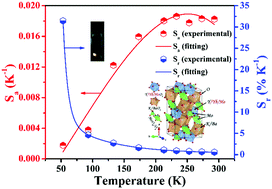Exceptional low-temperature fluorescence sensing properties in novel KBaY(MoO4)3:Yb3+,Ho3+ materials based on FIR of Ho3+ transitions 5F5(1) → 5I8/5S2 → 5I8†
Abstract
In this report, a series of novel KBaY(MoO4)3:Yb3+,Ho3+ (KBYMO:Yb3+,Ho3+) materials with intense up-conversion (UC) luminescence properties were synthesized using a high-temperature solid-state reaction method. Upon 975 nm near infrared (NIR) laser excitation, KBYMO:Yb3+,Ho3+ mainly showed two emission bands at around 544 and 658 nm, as well as a feeble one at around 755 nm, corresponding to Ho3+ 5F4,5S2 → 5I8, 5F5 → 5I8 and 5F4,5S2 → 5I7 transitions, respectively. The UC luminescence mechanism in this kind of material was determined to be a two-photon process, including simultaneous energy transfer from Yb3+ to Ho3+. In order to explore its potential applications in low-temperature fluorescent thermometers, the temperature-dependent behavior (53–293 K) of KBYMO:0.60Yb3+,0.01Ho3+ as a representative was investigated in detail. Based on fluorescence intensity ratio (FIR) technology, the calculated FIR values of I640/550 (5F5(1) → 5I8/5S2 → 5I8) in KBYMO:0.60Yb3+,0.01Ho3+ (53–293 K) were adopted as the original data, which have been rarely used in previous systems. Therefore, the optimal absolute sensitivity Sa and relative sensitivity Sr were determined to be 0.0186 K−1 (233 K) and 31.45% K−1 (53 K), respectively, showing its potential as a key component material in low-temperature fluorescent thermometers.



 Please wait while we load your content...
Please wait while we load your content...